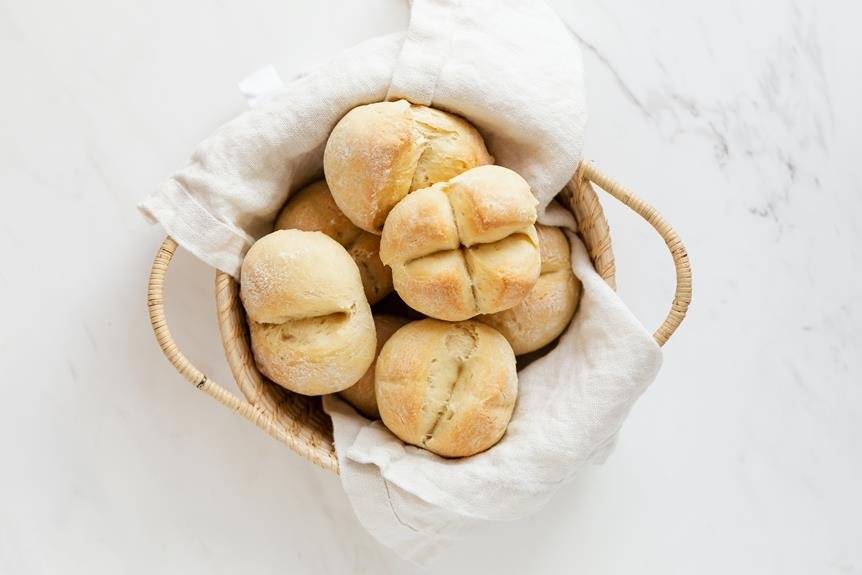Did you know that bread mold can sometimes be white? It may come as a surprise, but this phenomenon is not uncommon.
In this article, we will explore the causes of white mold on bread, how to identify it, and the dangers of consuming moldy bread. We will also provide tips on preventing and getting rid of white mold.
So, if you have ever wondered about the white mold on your bread, read on to uncover the scientific truth behind this curious occurrence.
Key Takeaways
- White bread mold is typically caused by a fungus called Penicillium.
- Factors such as humidity, temperature, and the presence of other microorganisms influence the growth of white mold on bread.
- Improper storage, including humid environments and lack of airtight containers, can contribute to the development of white mold.
- Consuming moldy bread can lead to food poisoning and respiratory problems due to the production of mycotoxins by white mold.
White Bread Mold: A Surprising Phenomenon
While it may seem counterintuitive, you may be surprised to learn that white bread mold can indeed exist. Mold is a type of fungus that thrives in moist and warm environments, and it can grow on a wide variety of organic materials, including bread. The most common type of bread mold is black or green in color, but there are also instances where white mold can develop.
White bread mold is typically caused by a different species of fungus called Penicillium. This fungus is commonly found in the environment and can easily contaminate bread if the conditions are right. The growth of white mold on bread is influenced by factors such as humidity, temperature, and the presence of other microorganisms.
When white mold develops on bread, it appears as white or off-white spots or patches. These patches can gradually spread and cover the entire surface of the bread if left untreated. While white bread mold is generally harmless and can be safely removed by discarding the affected portions, it's important to note that some people may be allergic to mold and should avoid consuming moldy bread.
Understanding the Causes of White Mold on Bread
To understand the causes of white mold on bread, let's delve into how this phenomenon occurs. White mold on bread is a common occurrence and is caused by various types of fungi, including species of Penicillium and Aspergillus. These fungi thrive in warm and moist environments, making bread an ideal breeding ground.
One of the main factors contributing to the development of white mold is improper storage. If bread is kept in a humid environment or not stored in an airtight container, it becomes susceptible to mold growth. Additionally, bread that is past its expiration date or has been contaminated with mold spores during production is more likely to develop white mold.
To further understand the causes of white mold on bread, let's take a closer look at the conditions that promote its growth:
| Factors Promoting White Mold Growth | Factors Inhibiting White Mold Growth |
|---|---|
| High humidity | Low humidity |
| Warm temperatures | Cold temperatures |
| Lack of air circulation | Adequate air circulation |
| Presence of mold spores | Absence of mold spores |
Identifying White Bread Mold: Signs and Symptoms
To identify white bread mold and its signs and symptoms, you need to closely examine the affected areas for distinct visual characteristics. White bread mold is caused by various types of fungi, such as Rhizopus stolonifer and Penicillium spp. These fungi thrive in warm and humid environments, making bread an ideal breeding ground. When examining your bread for signs of white mold, look for small, fluffy white patches that may appear fuzzy or powdery. These patches can spread quickly and cover large areas of the bread's surface.
In addition to the visual characteristics, the presence of a musty or earthy odor is another sign of white bread mold. This odor is a result of the metabolic activities of the fungi. If you detect this smell, it's a clear indication that white mold has started to grow on your bread.
It is important to note that white bread mold can sometimes be mistaken for other types of mold, such as blue or green mold. However, white mold typically has a fluffy, cotton-like texture, distinguishing it from other types.
If you find white mold on your bread, it's recommended to discard the entire loaf, as the mold can produce toxins that may be harmful if consumed. It's always better to err on the side of caution when dealing with mold-contaminated food.
The Dangers of Consuming White Moldy Bread
Consuming white moldy bread can pose significant health risks to you. Mold is a type of fungus that can grow on various food items, including bread. While some people might think that white mold on bread is harmless, it's essential to understand the potential dangers associated with consuming it.
Here are three reasons why you should avoid eating white moldy bread:
- Toxic substances: White mold on bread can produce mycotoxins, which are toxic substances that can cause various health problems. These mycotoxins can negatively affect your respiratory system, causing symptoms like coughing, wheezing, and difficulty breathing.
- Allergic reactions: Mold spores can trigger allergic reactions in some individuals, especially those with existing allergies or asthma. Consuming white moldy bread can lead to symptoms such as sneezing, itching, nasal congestion, and skin rashes.
- Food poisoning: White mold on bread can also be a sign of bacterial or fungal contamination. Consuming moldy bread can lead to food poisoning, causing symptoms like nausea, vomiting, diarrhea, and abdominal pain.
Preventing and Getting Rid of White Mold on Bread
To prevent and eliminate white mold on bread, it's essential to practice proper storage and hygiene techniques.
White mold spores are present in the air and can easily find their way onto your bread if not properly stored. To minimize the risk of white mold growth, always store bread in a cool, dry place, such as a bread box or pantry. Avoid storing bread in plastic bags or containers, as they can trap moisture and create a favorable environment for mold growth.
Additionally, make sure to inspect your bread regularly for any signs of white mold. If you notice any fuzzy white patches or an unpleasant odor, discard the affected loaf immediately. It's important to remember that white mold can spread quickly, so it's crucial to remove any contaminated bread from your storage area to prevent further contamination.
To further prevent white mold growth, maintain good hygiene practices when handling bread. Always wash your hands before handling bread, and use clean utensils to slice it. Avoid touching the bread directly with your hands, as this can transfer mold spores onto the loaf.
Conclusion
In conclusion, white bread mold is indeed a surprising phenomenon. It's caused by various types of mold, such as Aspergillus and Penicillium, which can thrive in moist and warm environments.
Identifying white bread mold can be done by observing the presence of fuzzy white patches on the bread's surface. Consuming white moldy bread can pose health risks, including allergic reactions and respiratory issues.
To prevent and eliminate white mold on bread, it's essential to store it in a cool and dry place and discard any moldy slices promptly.






0 Comments